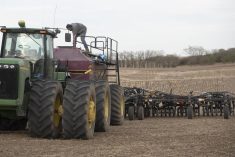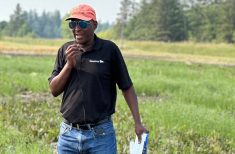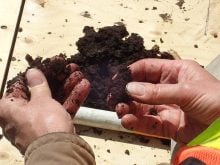There’s a common assumption that when winter grips the Prairies, there’s no activity in the soil. As a result, urea or ammonium-based fertilizers applied in late fall aren’t thought to emit nitrogen during winter.
Reynald Lemke, a research scientist with Agriculture and Agri-Food Canada, flipped this idea on its head this year, proving that biological activity in soil is year-round and so are nitrogen emissions.
“There are N transformations that are ongoing through the winter period, even when you get that fertilizer in (the ground) very close to freeze up,” Lemke told those who attended the recent Canola Week.
Read Also

Manitoba boosts stake in cereals centre to $23.5 million
Premier Wab Kinew said the additional project funds will help ‘Trump-proof’ the provincial economy.
“The emissions are fairly low, as far as N2O (nitrous oxide), and we don’t know for sure, but there’s a good chance they’re accompanied by much higher emissions of N2 (nitrogen).”
Previous studies showed a bimodal seasonal emission pattern, with the highest emission of nitrogen and its derivatives in spring and early fall. Wet and warm conditions exacerbate this, such as snowmelt and soil thaw in spring or significant rainfall, Lemke said..
“When things really happen is where you get wet conditions, really wet conditions, and available nitrate, you have lots of opportunity for denitrification straight up, which is moving that nitrate into N2 or into N2O, or nitrifier denitrification, and then, of course, there could be leaching surface runoff and so forth. Each of those … has the possibility of secondary emissions of N2O or N2.”

Research from Eastern Canada revealed winter nitrogen emissions can be significant but until now, western Canadian researchers explained that by saying the east has deeper snowpacks to keep soil warm, or that surface soils don’t fall too far below the freezing point.
A recent publication from the universities of Saskatchewan and Guelph used flux towers to measure winter emissions through to spring. Flux towers measure eddies of gases in the air. This study showed ongoing low levels of emissions on the Prairies.
To see for himself, Lemke examined nitrogen emissions through “automated flux”, a semi-continuous system that uses soil probes to investigate how and why nitrogen treatments are emitted.
His team’s goal was to analyze the N2O emitted from soil by comparing different treatments and understanding what other factors were involved. They compared urea, a dual inhibitor (Super U), and no treatment.
Treatments were applied to test areas on Oct. 31, 2022, and Oct. 17, 2023, to measure emissions from the late fall to early winter periods. Plant root simulator probes were installed immediately after fertilizer application in the fall and left in the ground for the winter.
The probes are ion specific and accumulate either ammonium or nitrate. They were used to monitor N transformations, nutrient transformations and microbes. The team sampled and measured four to five times in a 24-hour period.
“We tried to keep it running 24/7 but as you can imagine, these are challenging conditions,” Lemke said. “The system wasn’t really designed for over winter, but it did surprisingly well.”
In the 2022 to 23 period, probes revealed N2O emissions.
“When you see N2O emissions, it’s a signal that there’s probably wider N loss, sometimes much, much higher losses of N2 than N2O,” said Lemke. “But unless we have very sophisticated approaches and technology to do so, we can’t measure the N2. We can only measure the N2O.”
The first four months of 2023 had similar levels of nitrogen emissions, differing slightly from levels in late fall. Lemke said this suggests microbial activity and N transformations. During the 2023-24 period, much of the same was seen. Emissions were a bit lower, but evidence continued to suggest ongoing transformations.
In early March 2024, emissions had “pretty much shut down.” Lemke said it’s unclear if activities stopped or if the soil surface had frozen and capped off. Either way, it reduced the atmospheric exchange.
During a question period, Lemke said that with the abnormal winter of 2023-24, his team was able to study a range of conditions.
“Short story is, we’re seeing emissions throughout the entire winter period. They’re low. So, during the summer, we’ve probably seen perhaps several times that amount.”
The other significant finding was that most transformations occurred on plots treated with urea, while Super U appeared to slow down winter nitrogen transformations. Urea had the highest nitrate, followed by Super U, followed by the untreated control. Urea also had the highest ammonium rates.
Lemke said additional study findings hint that Super U may reduce emissions, as opposed to only slowing down nitrification rates.
“In any case, all indications are that we do have activity through that entire time period, and as I said, suggesting that we also have then transformations.”
While a small amount of nitrogen is emitted during the winter months, from an atmospheric point of view even small amounts are significant, especially if they’re paired with N2O emissions, which Lemke said “might be 20 times or greater than what we’re measuring (with nitrogen)”.
His next steps are to analyze soil temperature data. Snow acts as an insulator, causing an interaction, but the real question is which comes first: lower soil temperature or lots of snow?
“The short answer, I guess, is that that interaction between snowpack and the timing that it comes and soil temperature through the time period, how fast it freezes, how deep it freezes, clearly, there’s a strong interaction.”
















